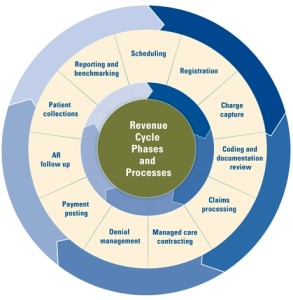It is no secret many hospitals are struggling with their revenue cycle and less than stellar bottom lines. Healthcare reform, ICD-10 implementation and shifting healthcare environments are making it more difficult to remain fiscally healthy and financially viable. But some organizations are thriving during this complex time of changes and they all have one thing in common, despite changes and the heavy obligations of daily tasks they focus on continuous revenue cycle improvement utilizing 4 tried and true strategies that not only juice up the revenue cycle, but lead to sustained financial improvement over time. Here is what they do:
they do:
1. Focus on Pre-Authorization and Pre-Certification
Revenue cycle optimization begins at point of entry, when a patient or client first presents for treatment. This crucial step in the revenue cycle process eliminates a separation of the clinical and the business aspects of a practice, and can lead to improved patient satisfaction. Determine multiple ways to obtain pre-certification for services, these can include online registration options such as email or web portal, but should also include personal service options to make sure that you serve all demographics. Knowing that a patient is pre-certified for care can eliminate revenue cycle hassles down the road such as denials or appeals. Pre-certification also allows the clinical side to be more informed regarding care options available to patients. Part of making patient care successful, is having it focus on patient preferences, which for many, includes affordability. Pre-certification can eliminate payment confusion down the road and will help the patient be informed regarding the care they are getting and the costs they can expect.
2. Set Revenue Cycle Benchmarks and Goals
Does your billing department have goals and benchmarks in place currently? If not, now is the time. Staff are more informed and perform better if they are aware of a goal that their department is trying to reach. Common revenue cycle goals are % of clean claims submitted, or IBNR (invoiced, but not received) goals. One practice has a goal of trying to ensure that all services are processed and payment is received within 180 days. Here are some effective tips when setting Benchmarks and Goals for your Billing/Revenue Staff
- Make sure that staff are aware of the goals/benchmarks including where they currently stand
- provide up to date reporting on how effective staff are at reaching their goals at regularly scheduled intervals (such as weekly or monthly)
- Make the goal attainable, but challenging. Start with a small goal and work your way up consistently to ensure buy-in and encourage morale
- Incentivize the goals – give staff greater motivation by creating an incentive program surrounding the goals and benchmarks you hope to achieve
- Involve staff in benchmarking and goal discussions. Often someone who deals with the issue directly can provide greater insight into where the obstacles in your revenue cycle are. Is there a bottleneck in communication? Are there common processing errors? Are front desk inefficiencies detrimentally impacting the revenue cycle? Chances are your staff will have the answers and some bright ideas on how to correct the issue
3. Optimize Your Organizational Structure
Do you currently see a lack of communication between departments such as clinical and non clinical associates? Are Billing and Collections handled by separate teams with little interface? How is the flow from a front desk operations perspective? These areas should be assessed and optimized as part of a plan to juice up your revenue cycle.
- Ensure that you are facilitating communication between all departments whether through flash meetings, newsletters, or dedicated leadership meeting
- Put in place tools that allow for effective communication and collaboration across departments
- send standard updates regarding the progress of the revenue cycle to teams/departments in other areas so that everyone is informed of performance and impacts
- look for duplication and waste in the processes regarding revenue cycle improvement
4. Manage Your Denials
Organizations can see a dramatic increase in their bottom line by simply managing denials more effectively. BHM recommends a denial management strategy based on the following CORE Principles of Denial Management. For full information on how to manage denials and recoup losses please click here: MANAGE DENIALS TODAY






